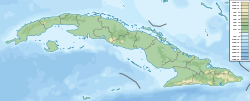Península de Guanahacabibes
| Península de Guanahacabibes | ||
| Geographical location | ||
|
|
||
| Coordinates | 21 ° 54 ′ N , 84 ° 28 ′ W | |
| Waters 1 | Gulf of Mexico | |
| Waters 2 | Caribbean Sea | |
| surface | 1 200 km² | |
The Península de Guanahacabibes is a peninsula on the western tip of the island of Cuba , which has been protected as a biosphere reserve since 1987 .
geography
Guanahacabibes belongs to the municipality of Sandino in the province of Pinar del Río . The peninsula has an area of 1200 km² and is hardly populated. At the end of the peninsula facing the Yucatán Strait is Cabo de San Antonio, the westernmost town in Cuba. On its south side, it includes the sandy beach-lined bay of Corrientes, which ends with Cabo Corrientes as the southernmost point. The terrain of the peninsula is flat and consists of young limestone formations that have been strongly shaped by tropical karst . There are many caves and sinkholes .
history
In the phase of radicalization of the Cuban Revolution , Che Guevara had a forced labor camp set up in Guanahacabibes from autumn 1960 . He had employees of the revolutionary government sent there, who were often only suspected of vaguely defined violations of the "revolutionary morality" propagated by him. They should prove themselves through hard physical work and return to the government apparatus as "reformed" revolutionaries. In 1962, regulations were enacted in which 32 misconducts in the conduct of office to be punished with detention were listed, including non-fulfillment of production targets caused by negligence. According to a report by a Cuban lawyer documented by the Inter-American Commission for Human Rights in 1963, 4,000 people were held there at the time. In September 1961 alone, 2,000 people were sentenced to stay in the Guanahacabibes penal camp. As an example of citizens classified by the government as "anti-social elements" to be transformed, the commission report mentions a man personally known to the lawyer who was sentenced to six months in a camp for repeated drunkenness on Saturdays and Sundays. The practice of arbitrary extrajudicial internment of Cubans who were not accused of any specific criminal offenses, first practiced in Guanahacabibes, was repeated in later years: the best-known examples were the labor camps for homosexuals , Jehovah's Witnesses and other young men (UMAP) operated from 1965 to 1967 .
To protect the rich flora and fauna, the peninsula was declared a Biosphere Reserve by UNESCO in 1987 . For beach and diving tourism there is a hotel complex in María La Gorda on the south side of the peninsula. There is a crocodile farm (with the endemic nature Cuba- or Cuban crocodile ), which can be visited.
Flora and fauna
The north coast of the peninsula consists mainly of mangrove forests , while the southern coastline is lined with sandy beaches and coral banks. The vegetation away from the coast is a dry forest, with seasonal green trees (shrubs and mostly low trees). Areas that have been cut down are savannahs. Precipitation seeps away immediately (karst), which means that apart from extensive grazing, agriculture is not possible. The area is very biodiverse, with 172 species of birds particularly notable, including parrots, owls and the smallest bird in the world, the bumblebee hummingbird (or bee elf, Mellisuga helenae ). The endangered sea turtles , which use the beaches of the peninsula to lay eggs, are remarkable .
Web links
- Península de Guanahacabibes in the Cuban state online encyclopedia EcuRed (Spanish)
- Centro de Rehabilitación de Uvero Quemado in the Cuban state online encyclopedia EcuRed (Spanish)
- Parque Nacional Guanahacabibes in the Cuban state online encyclopedia EcuRed (Spanish)
- Donde el sol dice adiós, in: Caribe issue 58 (Spanish)
Individual evidence
- ^ Jorge Castañeda : Compañero: The Life and Death of Che Guevara. Knopf Doubleday, New York 1998, p. 178 (English)
- ↑ Helen Yaffé: Che Guevara: The Economics of Revolution. Palgrave Macmillan, Basingstoke 2009, pp. 216–222 (English)
- ↑ Inter-American Human Rights Commission: Cuba 1983 - Chapter X, Annual Report on Cuba 1983 , on the Commission's website, accessed on February 24, 2015 (English)
- ↑ Inter-American Human Rights Commission: Cuba 1963 - Capítulo III, Annual Report on Cuba 1963, on the Commission's website, accessed on February 24, 2015 (Spanish)
- ^ Samuel Farber : The Resurrection of Che Guevara, in: New Politics, vol. 7, no.1 from summer 1998 (English)
- ↑ Joseph Tahbaz: Demystifying read UMAP: The Politics of Sugar, Gender, and Religion in 1960s Cuba, in: Delaware Review of Latin American Studies Vol. 14 No. 2 of December 31, 2013, accessed February 24, 2015
- ↑ Article at granma.cu dated 09/27/2006 ( Memento of the original dated January 4, 2008 in the Internet Archive ) Info: The archive link was inserted automatically and not yet checked. Please check the original and archive link according to the instructions and then remove this notice.
